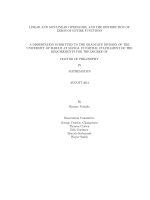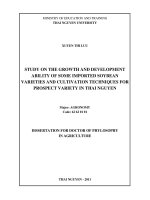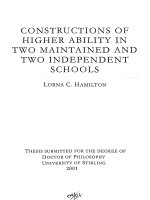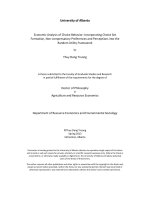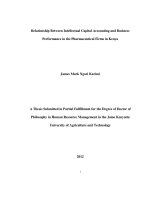Kombucha leather preparation and characterization doctor of philosophy major biomaterials and biocomposites
Bạn đang xem bản rút gọn của tài liệu. Xem và tải ngay bản đầy đủ của tài liệu tại đây (14.17 MB, 56 trang )
Hi Tomas Bata University in Zlín
Centre of Polymer Systems
Doctoral Thesis
Kombucha leather: Preparation and Characterization
Kombucha kuZe: Priprava a charakterizace
Author:
Hau Trung Nguyen, M.Sc
Degree Programme:
P3924 Material Sciences and Engineering
Degree course:
3911V040 Biomaterials and Biocomposites
Supervisor (Tutor):
Assoc. Prof. Nabanita Saha, M.Sc., Ph.D
Consultant:
Prof. Ing. Petr Saha, CSc
Zlin, August 2022
© Hau Trung Nguyen
Published by Tomas Bata University in Zlin in the Edition Doctoral Thesis.
The publication was issued in the year 2022
Key words in Czech: Kombuchova kuze, Veganska huze, Bakterialni celuloza
ziskana z Kombuchy, Bakterialni celuloza, Optimalizace, Navrh experimentu.
Key words: Kombucha
leather,
Vegan
leather, Kombucha-derived bacterial
cellulose, Bacterial cellulose, Optimization, Design of Experimen.
Full text of the doctoral thesis is available in the Library of TBU in Zlin.
ISBN 978-80-.............
CONTENTS
ABSTRACT .ooeecccccccccccceeeeesceceecseseneceseecensseeeesaeensseceeseeenecesnessesseeesiteensseesesaenetees 1
ABSTRAKT..................
SH
Hà HH HH 1H11
1H Hay 3
ACKNOWLEDGEMENT tiss be snoese84opBistRGEESSIEHGHDHSEISSEDLRELSIRHSEEEISS-B99030008888 5
LIST OE/EIGUREHieecsssititetibibbalebaBtSCEGSEHAXEHAE4SENRHIPREDSSERSSSHSRRGAEESRHSER 8
LIST OF TABLES ......ccccceccecccccecceeeseeecsesceeeeeenenseeeeeseeeneeesuecenssieeesisueneseeeeeatatns 10
LIST OF ABBREVIATIONS AND SYMBOLS. .......cccccccscceeeteettneeeeetettees 11
LIST OF PUBLICATIONS....................
c2 HH
He
1. BACKGROUND.................
S1
HH1
13
Ha 15
1.1 Genuine leather and leather Indusfry......................---- ¿2 2c 2212 sscsses 15
1.2 The genuine leather processing and 1ts pollution sources........................ 16
1:3 Kombpucha leäth€fF;::::ississsissssssssitritierioidtitDigtOIGDIED4GSDđL9DEti0053x01s8 20
1.4 The properties and preparation of Kombucha leather............................-- 22
1.5 Bacterial cellulose (BC) and Kombucha-derived bacterial cellulose (KBC)
seeecueseesceeeecaeseveceesessenececseseesceeseciesececeeeesaeeaneseeeesaseeeeseceesesaeesecurcesetieeetieseseseeeetets 24
I9
oi u06 on...
..........
31
1.7 Design of Experiment and optimization of BC/KBC production............ 34
1.8 Modification of BC/KBC hydrophobIeIfV.................
óc các che
38
1.9 Polymers in ]eatheT'DTOCCSSÍTĐ s:xs:ix:z:ii1ss610122121131001114610031010594058515
080100 40
1.10. The combination between BC/KBC and polymers..........................-.--- 45
2. EXPERIMENTATION..........................
các nh HH
HH He
2.1 Mater1aÌS................-
-- - T11 n1 ST
ST 1n
E TT TH KH KH KT
52
key 52
2.1.1 Bio-waste SOUTG€S....................
.
0Q TT HT TH TH ng HT kg kg kh nen rxy 52
2.1.2 Polymers and other chetm1€aÌs...........................---- ¿2-2222 S2E 121 xsrsres 53
2.2 KBC produetion......................--
.- c c 121111121111 111111111111 011111 11 1111818111
tk HH 53
2.2.1 Activation of bacterial SÍTA1H.................
ác cá St nh nh
He
53
2.2.2 Evaluation of KBC production using bio-wasfe sources................... 54
2.2.3 Optimization of KBC production using sour whey wasfe................. 56
2.2.4 KBC production in large containers .........0....ccccccceceeeeteteteeteeteseeeaes 59
2.3 Fabrication of Kombucha leather .......0..0. cc cecceceeteeeeeeeeeeeeneetesetteenteeneens 61
2.3.1
Preparation
of
PCL/PVA/PLA..........
leather-like
St SH
biocomposites
HH
based
HH
on
KBC
11H
and
G1
2.3.2 Preparation of leather-like biocomposites based on KBC and PU/PLA
2.3.3 KBC powders hydrophilie modificatlon..............................
c2 cccccccccsc- 64
2.3.4 Optimization of Kombucha leather preparation using KBC/PU/PLA
¬—
65
2.4 Characterization analysis of BC/KBC and prepared leathers .................. 67
2.4.1 Dry weight of BC/KBC and pH value of the fermentation media.....67
2.4.2 Scanning electrO' HICTOSCODY .....................
0 22 222121121111 1e
67
2.4.3 Fourler transformed Infrared spectrOSCODY.......................à.
cài ceseeằ. 68
2.4.4 Thermal anaÏyS1S....................
2.4.5 X-ray diffraction anaÏyS1S.................
-.-
2c 2212111 111112 11112111181 111111111 111111111 ket 68
..-- c c1
221151151 141111101111 181 ke 69
2.4.6 The water absorption capacIfy of KBC powder...............................c- 70
2.4.7. Surface wettabIlity measureImenifs.....................
..- -- c2: S212 s2 se. 71
2.4.8. Mechanical anaÌVS15......................
-- c. . n2. 2 2S 115111111111 111k et 72
4.4.9. Blodegradation sfUd16S.......................-c 2.1 122 S1 9111111101111 key 72
CN
Bi
cii/.YININỌIaadđdidẳda..
3. MOTTVATION FOR THE DOCTORAL
4. AIMS OF DOCTORAL
STUIDY.........................c.ccccccscsc2 73
THESIS AND BRIEF SUMMARY...................... 74
5, CONCLUDING: REMARKS
Š.]:COTGÌHSIOH¿iieiziinssiipri
73
isnsosnndetoiLBALROGHBSSSERDBSIRGSGGISGGIPGSS0093841S041 95
tua bai dd š8t0Đ ĐÀ ĐA EIHSHSBEUHHSUSEHIERRHIENEHEEĐ4B 95
5.2 Contribution to the SOCI€ẨY.....................-..
22. 2211211211111 HH
nhe 97
h8
0n
ó(OaaaaiđẢÝŸỀẼÝÝẢỶÝÝ..
35084009512 ................
PUBLICATION I
PUBLICATION II
PUBLICATION II
PUBLICATION IV
PUBLICATION V
PUBLICATION VI
CURRICULUM VITAE
98
99
ABSTRACT
Kombucha leather is bacterial cellulose-derived leather developed as vegan
leather possibly well-respond to consumers' expectations regarding safety,
function, aesthetics, social responsibility, reducing pollution emissions of the
leather industry, and also transforming the bio-wastes into useful materials. In
this doctoral thesis, Kombucha leather was prepared via the combination
between polymers and cellulose harvested from kombucha fermentation using
bio-wastes that comprise two basic stages. In Kombucha-derived bacterial
cellulose (KBC) production step, three investigated bio-wastes (sour whey
waste, waste apple juice, brewer's spent grains) all displayed the brilliant
efficiency in cellulose biosynthesis of Komagataeibacter xylinus compared to
traditional kombucha and HS standard media, especially, superiority dry
weight accumulated in trials contaming sour whey waste (12.59 and 12.81
g/L). The fermentation optimization has then achieved an outstanding KBC
dry weight (20.14 + 0.62 g/L) accompanied by maximizing the amount of
treatment-required waste with the optimum formulation of 1000 mL/L sour
whey waste, 87.39 g/L cane sugar, 6 g/L black tea, and 78.91 mL/L bacteria
volume, under 21 cultured days at 30 °C. Applying on the large containers, the
most responsible fermentation batch was obtained at the cultured medium
depths of 0.5 cm and low residual bacteria suspension volume of only 72.31 +
8.74 mL. The characteristics of produced cellulose membranes show no
significant differences for all samples compared to bacterial cellulose from HS
standard medium. In Kombucha leather fabrication phase, leather-like mat
based on KBC/PU/PLA exhibited remarkable mechanical properties compared
to other components. Compressive temperature and time also directly affect
structures and water resistance capacity of the prepared biocomposite.
Especially,
KBC
were
treated
with
dimethyldichlorosilane,
hexadecyltrimethoxysilane,
vinyltriethoxysilane,
and
3aminopropyltriethoxysilane have spectacular improved their hydrophobicity.
This KBC modification also played a vital role in enhancing compatibility or
homogenous blending to provide a stable structure for produced silane-treated
KBC-based leather mat. Ultimately, the ingredient and condition of kombucha
leather preparation were optimized with outstanding values of elastic modulus,
biodegradable and water contact angle respectively reached at 44.07+40.51
N/mm’, 1.3140.04 %, and 94.84+1.59° from optimum leather-like mat
containing KBC (13.74 % w/w), polyurethane elastomer (73.89 % w/w), and
polylactic acid (12.50 % w/w), compressed at 155 °C for 5 min. Its
morphology, chemical structure, thermal stability, mechanical strength, and
biodegradability were characterized and compared to existing commercial
leathers. Basically, the results show a possible response to the essential
requirements of this Kombucha leather that prospective application in
footwear, bags, or interior covering products.
Keywords: Kombucha leather, Vegan leather, Kombucha-derived bacterial
cellulose, Bacterial cellulose, Optimization, Design of Experiment.
ABSTRAKT
Kủše Kombucha Je kủše odvozená z bakteriální celulózy vyvInutá jako
veganská kủše, která mošná dobFe odpovídá ošekáváním spotfebitelủ ohledné
bezpeénosti, funkce, estetiky, spole¢enské odpovédnosti, snizovani emisi
znecisténi kozedélného primyslu a také premény biologického odpadu na
uziteéné materialy. V této dizertaéni praci byla kombuchova kiize piipravena
kombinací polymerủ a celulózy sklizené z fermentace kombuchy pomoci
bioodpadủ, které se skládají ze dvou základních fazi. Ve vyrobnim kroku
bakterialni celul6zy odvozené z Kombuchy (KBC) ti zkoumané biologické
odpady (odpad z kyselé syrovatky, odpadni jableéna Stava, pivovarské mlato)
vSechny
vykazovaly
vynikajici
uéinnost v biosyntéze
celulozy
u
Komagataeibacter xylinus ve srovnani s tradi¢éni kombuchou a standardnimi
médii HS, zeyména vySsi suSina nashromazdéna v testech obsahujicich odpad
z kyselé syrovatky (12,59 a 12,81 g/l). Optimalizace fermentace pak dosahla
vynikajici suché hmotnosti KBC (20,14 + 0,62 g/l) doprovazené maximalizaci
mnošství odpadu potfebného pro upravu s optimalnim sloZenim 1000 ml/1
odpadu kyselé syrovátky, 87,39 ø/1 tfinového cukru, 6 g/l éerného éaje a objem
bakterii 78,91 ml/l, za 21 dnt kultivace pit 30 °C. Pit aplikaci na velké nadoby
byla nejzodpovédnéj8i fermentaténi davka ziskana pri hloubce kulttvaéniho
média 0,5 cm a nizkém objemu suspenze zbytkovych bakterii pouze 72,31 +
8,74 ml. Charakteristiky vyrobených celulózových membrán nevykazuJí zadné
vyznamne rozdily pro vSechny vzorky ve srovnani s bakteriální celulózou ze
standardniho média HS. Ve fazi vyroby ktze Kombucha vykazovala rohoz
podobna ktizi na bazi KBC/PU/PLA pozoruhodné mechanickeé vlastnosti ve
srovnani s jinymi soucastmi. Tlakova teplota a €as také ptimo ovliviiuji
struktury a vodéodolnost piipraveného biokompozitu. Zeyména KBC byly
oSetreny
dimethyldichlorsilanem,
hexadecyltrimethoxysilanem,
vinyltriethoxysilanem
a 3-aminopropyltriethoxysilanem,
které výraznš
zlepSily svou hydrofobnost. Tato modifikace KBC také hrala zasadni roli pri
zlepSovani kompatibility nebo homogenniho smichani, aby poskytla stabilni
strukturu pro tuto kozenou podlozku na bazi KBC oSetfenou silanem. V
konešném đủsledku byly pÝísady a podmínky pFípravy Kủše Kombucha
optimalizovany s vynikajicimi hodnotami modulu pruZnosti, biologické
odbouratelnosti a thlu kontaktu s vodou, v tomto pofadi, dosazenych na 44,07
+ 0,51 N/mm2,
1,31 + 0,04 %, a 94,84 + 1,59°
z optimální rohoše podobné
ktze obsahujici KBC (13,74 % hmotn./hmotn.), polyuretanovy elastomer
(73,89 % hmotn./hmotn.) a kyselinu polymléénou (12,50 % hmotn./hmotn.),
lisované pri 155 °C po dobu 5 minut. Jeji morfologie, chemicka struktura,
tepelna stabilita, mechanicka pevnost a biologickaé odbouratelnost byly
charakterizovany a porovnany se stavajicimi komerénimi usnémi. Vysledky v
zasadé ukazuji mošnou reakci na zakladni pozadavky této Ktze Kombucha
usné, ktera se muze uplatnit v obuvi, ta8kach nebo vyrobky pro pokryti
interiéru.
Kligova
slova:
Kombuchova
kiuze,
Veganska
kuze,
Bakterialni
celuléza
ziskana z Kombuchy, Bakterialni celuloza, Optimalizace, Navrh experimentu.
ACKNOWLEDGEMENT
This dissertation 1s the outcome of a wonderful doctoral study journey with
numerous learning and research opportunities. I would like to express my
heartfelt thanks to all of those who joined me and who help me to complete
this journey so valuable.
First of all, I would
like to present the most honest gratitude to my
supervisor, Assoc. prof. Nabanita Saha, and my consultant, Prof. Ing. Petr
Saha. Without their support, patience, and encouragement, my thesis would
have never been completed. Their close instructions and supervision have been
of critical importance for me to pass plentiful difficulties and stay on track
during
the whole
process.
They
provided
the best conditions
for me
to
continuously develop, learn, research, execute my plans, and were always there
at the critical yunctions of my research. Their guidances are always extremely
valuable in furthering myself as a science researcher.
I would
like
to express
my
deep
thanks
Ngwabebhoh and Dr. Smarak Bandyopadhyay,
to Dr.
Fahanwi
Asabuwa
“my best brothers” at The
Centre of Polymer Systems (CPS), Tomas Bata University in Zlin (TBU). They
gave me their best experience and research skills for biomaterial fabrication,
testing, and analysis. Their support and advice play an important role for me
to finish my problems in the learning, research, and Irving in Czech Republic.
My sincere gratitudes go to Prof. Ivo Kuritka, Prof. Vladimir Sedlarik, Dr.
Nibedita Saha, Dr. Oyunchimeg Zandraa, Dr. Haojie Fei, Dr. Probal Basu, Mr.
Michal
Studeny,
Dr.
Rahul
Patwa,
Dr.
Martina
Pummerova,
Miss.
Klara
Sedlakova, Miss. Martina Dostalova, the Scientists, Teachers, Members and
Students of CPS and UTB. They are great sources of support and inspiration
wherever I come across any trouble both in the study and life. Their sharing
and caring have not created only been pleasant but also knowledge enriching
to my journey in Czech Republic.
My
sincere
thank
to
Prof.
Alina
Sionkowska
and
Prof.
Katarzyna
Lewandowska, who gave me an opportunity to traineeship, and then, directly
guided me
in biomaterial research at their laboratories of the Faculty of
Chemistry of Nicolaus Copernicus University in Torun, Poland.
I also want to express my deep thanks to Tomas Bata University in Zlin
(TBU) for providing me with the necessary infrastructure, scholarship, and
additional financial support which allowed me to concentrate on learning and
research. I would like to bestride my sincere thanks to Kromilk A.S, Kromeriz,
Pivovar Malenovice, Zlin, and Bata shoe company in Dolni, Czech Republic
for giving me the necessary samples for my research investigation to complete
the doctoral thesis work.
My deep gratitude is to express to Industrial University of Ho Chi Minh
City (UH), Vietnam, and my colleagues at Institute of Biotechnology and
Food Technology (IBF) for giving me opportunity to pursue my doctoral study
at TBU
in Zlin, Czech Republic.
I must thankful
to my
colleagues
for
shouldering my tasks during my absence. I would also prefer sincere thanks to
the Teachers of my previous schools and universities.
My family deserves plentiful special words of thanks. The Parent's and
family members increasing teaching and support have been providing me with
a compact ground creating great peace of my mind in the present and further
life. I am deeply indebted for that noble sacrifice. Ultimately, I would like to
indicate my heartfelt gratitude to my wife, Lé Tram Nghia Thu, for her
conscientiousness in taking care of the family during my doctoral study period
to uplift my educational qualification. She is always standing beside me and
providing me with the necessary support to overcome
all challenges. My
profound thanks also go to my two little angels, Nguyén Lé Thao Nguyén (my
daughter) and Nguyén
Trung Nghia
(my
son). Their smiles are precious
motivation and light candles, which lead me through this tough but exciting
and extremely valuable journey to reach the goal.
LIST OF FIGURES
Figure 1 The genuine leather processing and associated material streams [15].
Figure 2 A design of a naturally dyed and waterproof biotechnological leather
from reconstituted bacterial cellulose [30]. ...0...0.cccccccccceceeeeeeeeeteeeeteeneeseeeaes 21
Figure 3 Schematic of (a) graphene/BC was prepared by in situ self-assembly
[31] and (b) KBC biosynthesis apply to bio-based composite as leather-like
I2
Figure
ETEZP
4
...............
Structure
of(a)plan
cellulose
and
(b)bacterial
23
cellulose
of Acetobacter xylimum [41]...0..0. ccc cece cece eee eeeceeeeeeteceeceseeaetaeeaeeeeeeseeeae 25
Figure 5 The life cycle of BC towards sustainable production [38]. ............. 26
Figure 6 BC synthesis and carbon sources metabolism in Komagataeibacter
b5 i00 5210751077
.............
27
Figure 7 BC production process from the pre-treatment of wastes [92]........ 31
Figure 8 Schematic of Kombucha fungus tea production [105]..................... 32
Figure 9 Kombucha fermentation and the influence factors of the optimization
(aunthor2s €labor8iOTiÌiisssssrisst3stittiilg6lisistoiiSDDEEISOSIEISSSSIESESEECISSEESISIES8E233 33
Figure 10 Flowchart of the optim1zation proeess [L2I]............................----- 34
Figure 11 Chemical strueture of baeterial cellulose [74].............................- 38
Figure 12 Chemical strueture of silane compounds.............................- -.-------- 40
†Igure 13 Chemical strueture oŸpoÏyIm€TS.....................
..- c S22 22h 41
Figure 14 Schematic of (a) preparation procedure of split microfiber synthetic
leather [156] and (b) membrane casting with coagulant bath [157]............... 42
Figure 15 Evaluation of KBC production with sour whey waste, waste apple
fruits, and brewed spent graIns (authorˆs elaboraflon)......................-...-..----+- 56
Figure 16 KBC production in large containers (authorˆs elaboration).......... 60
Figure
17 Preparation
of leather-like
biocomposites
based
on KBC
and
PU/PLA (authorˆs elaborafIOT))...................-.--- c 2c 121 1111111211 11111812111
63
LIST OF TABLES
Table
1. Uses, LD
INGUStry [7]...
50, and toxicity of some
chemicals used in the leather
+s4ăằ...ố..
19
Table 2. Properties comparison between plant cellulose and BC [40, 42].....24
Table
3. List
of BC
production
using
the
bio-waste
sources
(author’s
1106500000...
Table
4. List of recent optimization
studies of BC
production
Claboration). 22... 3a...
29
(author’s
36
Table 5 List of recent research about the application of the combination of
BC/KBC and various polymers and their Improved properftIes..................... 47
Table 6. Compositions of formulated media for KBC production [32]. ........ 55
Table 7. Experimental design for the optimization of KBC production [29].58
Table 8. Volume depths of the fermentation mediums in large containers [29].
Table 10. The experimental design for the optimization of Kombucha leather
preparation (unpublished WorK). . . . . . . . . . .
..--. c2 2121 2112111111 1101111281
10
66
LIST OF ABBREVIATIONS AND
SYMBOLS
3-D
3 dimensional
APS
3-aminopropyltriethoxysilane
ASTM
American standards testing methods
BC
Bacterial cellulose
BOD
Biochemical oxygen demand
CCD
Charge coupled devices
COD
Chemical oxygen demand
CZ
Czech Republic
đHạO
distilled water
DCDMS
Dimethyldichlorosilane
DOE
Design of experiment
FTIR
Fourier transform-infrared spectroscopy
HDS
Hexadecyltrimethoxysilane
HS
Hestrin and Schramm medium
LD
Lethal dose
PCL
Polycaprolactone
PEG
Polyethylene glycol
PLA
Polylactic acid
PVA
Polyvinyl alcohol
PVC
Polyvinyl chloride
11
PU
Polyurethane
KBC
Kombucha-derived bacterial cellulose
R&D
Research and Development
Relative humidity
SEM
Scanning electron microscope
TGA
Thermogravimetric analysis
THF
Tetrahydrofuran
VTS
Vinyltriethoxysilane
WAC
Water absorption capacity
WHC
Water holding capacity
XRD
X-ray diffraction
12
LIST OF PUBLICATIONS
Articles (with Jimp, available in Scopus and WoS)
Publication I:
Kombucha-derived
bacterial
cellulose
from
diverse
wastes:
a prudent
leather alternative. Hau Trung Nguyen. Nabanita Saha. Fahanwi Asabuwa
Ngwabebhoh.
Oyunchimeg Zandraa. Tomas
Saha. Petr Saha. Cellulose,
(2021), 28, 14, 9335-9353. dot.org/10.1007/s10570-021-04100-5, Q1, IF
5.044.
Publication I:
Development of novel biocomposites based on the clean production of
microbial cellulose from dairy waste (sour whey). Hau Trung Nguyen,
Fahanwi Asabuwa Ngwabebhoh, Nabanita Saha, Oyunchimeg Zandraa,
Tomas
Saha, Petr Saha. Journal
of Applied Polymer Science,
(2021),
e51433. doi: 10.1002/app.51433, Q2, IF 3.125.
Publication HI:
Preparation and characterization of nonwoven fibrous biocomposites for
footwear components. Fahanwi Asabuwa Ngwabebhoh, Nabanita
Hau
Trung
Lengalova,
Nguyen,
Petr
Urska
Saha.
Vrabié
Brodnjak,
Polymers,
Tomas
Saha,
(2020),
12,
Saha,
Anezka
3061.
doi:10.3390/polym1212301, Q1, IF 4.329.
Publication IV:
Silane
modified
Kombucha
cellulose-based
biocomposite
leather-like
mats: Preparation, optimization, and characterization. Hau Trung Nguyen.
Nabanita Saha. Fahanwi Asabuwa Ngwabebhoh.
13
Oyunchimeg
Zandraa.
Tomas Saha. Petr Saha. Manuscript is submitted to Sustainable Materials
and
Technologies
on 01/04/2022
(present
status
under
review
as on
17/06/2022).
Publication V:
Environmentally
Friendly
and
Characterization.
Nabanita
Saha, Fahanwi
Trung
Nguyen,
Petr
Europe
- Africa 2019,
Saha.
Animal
Free
Leather:
Asabuwa
Fabrication
Ngwabebhoh,
and
Hau
/nternational Polymer Processing Society
Regional
Conference, November
18 — 21, 2019,
Pretoria, South Africa. AIP Conference Proceedings 2289, 020049 (2020);
/>Publication VI:
Leather material with improved ecological parameters. Utility model. CZ,
33149 U1. Fahanwi Asabuwa Ngwabebhoh, Nabanita Saha, Hau Trung
Nguyen,
Tomas
Saha,
Petr
Saha.
Republic (2019).
14
Industrial Property
Office,
Czech
1. BACKGROUND
1.1 Genuine leather and leather industry
Genuine leather is a strong and durable natural material that obtained from
animal skins such as hides similarly bovines, buffaloes, goats, sheep, deer,
alligators, snakes, pigs after the tanning process and chemical treatments to
prevent the mherent
decay.
Genuine
leather processed
unique
properties
notably toughness, corrosion resistance, flexibility, elasticity, breathability,
waterproofness,
materials
and longevity
namely
artificial
[1-3]. Recently, genuine
leather,
synthetic
leather,
leather alternative
leatherette,
imitation
leather, faux leather, bonded leather, pleather, textile leather, or polyurethane
(PU)-leather are constantly growing, have low prices, are easy to be processed,
even can be continuously produced at industrial requirements. Nevertheless,
genuine
leathers
are still a priority chosen
and used
by their exclusive
properties, natural niceness, superior quality, unique aesthetics, and elegant
appearance with the touch of noble [2, 4].
Presently, the leather industry is still a long-standing large industry and
acquiring a significant place in the global economy, even, considered a national
commercial improvement engine, creating jobs, especially in countries with
emerging economies
[4-7]. The leather industry supplied the most widely
traded commodities
in the world in fashion,
accessories,
and
decor
furniture,
covering
footwear,
products,
apparel, bags, auto
as
well
as
new
multifunctional materials such as conductive leather, flame retardant leather,
self-cleaning
leather,
antibacterial
leather,
anti-fouling
leather,
oil-proof
leather, electromagnetic shielding leather, and X-ray shielding leather [3, 7-9].
15
